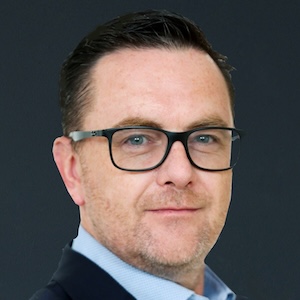
Ireland’s largest MEP consultancy, Ethos Engineering was shortlisted twice in this year’s Digital Construction Awards for its Living Lab, a smart building tool. Ethos developed the technology by testing it on its own headquarters in Sandyford, Dublin.
Living Lab incorporates a range of IoT technologies and sensors, measuring air quality, people counting, desk occupancy, energy metering and acoustics.
This wealth of data means Ethos can regulate and manage the building environment, adjusting ventilation, optimising space usage and enhancing staff engagement. Ethos felt this information would help it get a step closer to its own net zero targets, as well as improving its offering to clients.
“Implementing this in our own building allowed us to really play around with the systems and gave us the freedom to delve in and get an incredible understanding,” says Brian Coogan, director, digital services at Ethos. “From there we could go to our clients with real-time, data-driven insights.”

“Implementing this in our own building allowed us to really play around with the systems and gave us the freedom to delve in and get an incredible understanding.”
Secret sauce
Ethos also gained valuable insight into how performance data can influence the design process and ultimately alter final design configurations. The combination of building performance data, occupancy figures and power consumption intelligence was what Coogan saw as the secret sauce in helping clients towards their net zero goals.
“There’s a great deal of reporting data now available when it comes to sustainability and building performance,” explains Müge Karasahin, director of sustainability at Ethos. “With many older buildings, facilities managers may just have a bunch of Excel sheets and a list of energy bills. But with real-time data and continuous monitoring, you can spot trends much earlier and really understand the story of the building to make informed decisions.”
Coogan and Karasahin recognised very early on that “digital technology and sustainability work very closely hand in hand when it comes to the operations of a building.” This digital-first approach to sustainability has been recognised by independent experts, and Ethos became the first business in the world to achieve the WELL Performance Rating through the International WELL Building Institute, for its Dublin HQ Living Lab.
The WELL Performance Rating is a benchmark that encourages building owners and facility managers to use performance metrics to validate and improve the built environment, as well as the health and wellbeing of the people inside. It leverages building performance and occupant experience data to shift business decisions and organisational culture.

Data-driven decision making
Karasahin pinpoints the importance of real-time data in building a deeper understanding of a building’s performance, able to uncover unexpected insights. Karasahin explains: “On one occasion, we saw spikes in volatile organic compound levels early morning every Tuesday and didn’t immediately understand why. I checked in with reception and this is when the cleaners come in, so the spike was from the cleaning products that were being used. With sensors and real-time data, you can really visualise the impact of seemingly small things on factors like air quality, and how that contributes to the building’s overall performance.”
Quantity and quality of data is important not just for certification like WELL, but as part of organisations’ wider ESG reporting. Ethos heard from clients that there simply wasn’t a meaningful way to control a live building environment, with owners and facilities managers having to collate data from multiple systems (often in Excel format).
The Living Lab allows clients to bring together disparate data sets – air quality, occupancy, temperature, footfall and more – into a single visual platform, allowing for deeper analysis and data insights.

“With real-time data and continuous monitoring, you can spot trends much earlier and really understand the story of the building to make informed decisions.”
Bringing buildings to life
Ethos has developed Living Lab further, with Intelligent Lab (iLab), able to harness and analyse data to anticipate future needs and optimise decision-making, ensuring efficient and proactive operations.
While the first phase of the Living Lab project focused on ventilation and air quality, the second phase concentrates on energy, contributing towards Ethos’ net-zero pledge to become carbon neutral by 2050.
A data-driven, digital approach was crucial here – and Ethos turned to Autodesk to help bring the iLab to life. As Coogan explains: “At Ethos, we’ve fully embraced digital transformation. Our approach is to integrate technology seamlessly into our design processes. From BIM to advanced simulation tools, we leverage cutting-edge software to optimise our designs.”
Autodesk’s Tandem digital twin solution plays a crucial role in visualising and interpreting the vast amounts of data collected from buildings. It provides a single-pane-of-glass view, making it easier for both technical and non-technical stakeholders to understand and collaborate on building performance.
The digital twin technology offered by Tandem also allows Ethos to simulate and analyse building operations, leading to more informed decision-making and improved design outcomes than could be expected with the traditional data dashboard. While dashboards mainly display current or historical data with no predictive capability, digital twins can forecast future scenarios and enable predictive maintenance and strategic planning.
The collaboration between Ethos’s digital and sustainability teams exemplifies the potential of digital twin technology in enhancing building performance. By integrating real-time data with Autodesk Tandem, Ethos can ensure that its buildings not only meet design and certification standards, but also continue to perform optimally over time.
Smarter insight for smarter buildings
The shift towards smarter buildings is particularly important because of the explosion of hybrid working in recent years, and the fact that many spaces are now multi-purpose. This means that the “personality of the building”, as Coogan terms it, is much more complex and dynamic than ever before.
“Years ago, we used to build buildings for one purpose. Today, however, buildings are largely modular in design and must support a wide array of different industries and activities. Also, people don’t use buildings in the same way, even within the same industry and it’s more difficult to track where people are and how resources are being used, particularly in these incredible flexible spaces that are increasingly common,” says Coogan.
“With offices, it’s no longer everyone in and out at the same time every day. These buildings need intelligence and data to function smoothly and for facilities managers to know what’s going on now and what’s set to happen tomorrow based on known usage.”
Don’t miss out on BIM and digital construction news: sign up to receive the BIMplus newsletter.











